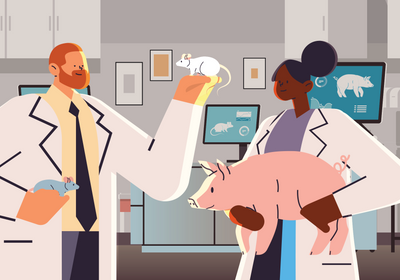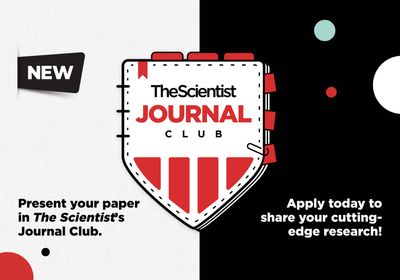ABOVE: Modified from © shutterstock.com, ProStockStudio
The goal of animal behavior research is to observe animals as they respond to stimuli (whether naturally occurring or experimentally provided) and draw conclusions based on their actions. These actions can be conscious choices or automatic responses, as in the famous studies by foundational Russian physiologist Ivan Pavlov. As interest in animal behavior has grown, the cheerful tale of Pavlov’s dogs drooling upon hearing a bell has become one of the best known anecdotes about the field, featuring in thousands of jokes, cartoons, and memes.
Unfortunately for both the field and the dogs themselves, the truth is considerably darker. To measure the output of the dogs’ salivary glands, Pavlov surgically exposed these glands and fixed saliva-collecting tubes to the dogs’ cheeks. The oft-quoted “bell” used as a conditioned stimulus was a sanitized version of reality, too. While Pavlov did use auditory stimuli in his experiments, including a buzzer, electric shocks were also in his repertoire. Yet these grim details are relatively unknown, even to experts in animal behavior or psychology. The shocking images of what happened to the dogs in the service of science are far from the public imagination, and Pavlov is frequently given plaudits for his scientific achievements while the ethical shortcomings of his work are rarely discussed.
He was not alone in undertaking experiments that would be refused approval by most ethics boards today. Some of the greatest figures of psychology or animal behavior often used methods that by modern standards were unethical. For example, as we describe in a recent paper, well known and often cited works by Harry Harlow on attachment and Martin Seligman on learned helplessness are rarely interrogated, and many scholars citing their work do not even realize that these scientists’ investigations involved animal suffering. For example, to reach the conclusion that infant rhesus macaques chose to cling to a soft terry-cloth-covered model as a surrogate mother and safe haven, rather than to a bare wire “mother” that gave milk, Harlow and colleagues subjected infant monkeys to social isolation from birth and repeatedly exposed them to fear-inducing stimuli such as mechanical wind-up toys. Seligman and colleagues devised experiments in which dogs were subjected to painful, inescapable electric shocks delivered to their feet. They found that the experience of not being able to escape such a stimulus resulted in an animal that was helpless and subsequently failed to move away from unpleasant stimuli, even if free to do so.
We now know that compromised welfare leads to compromised scientific results, as it can change animals’ responses or reduce their ability to learn.
The concern is not limited to whether subjecting animals to suffering in the name of science is morally acceptable. We now know that compromised welfare leads to compromised scientific results, as it can change animals’ responses or reduce their ability to learn. Thus, findings from experiments where animals suffered suboptimal welfare may have been compromised by stress—a dog that is in pain will respond differently than a healthy, relaxed animal, for example, while a normally social monkey raised in isolation will not show the same behavioral responses as one reared as part of a group.
These facts leave modern researchers with a conundrum: If these works are both seminal and ethically unsound, should they be cited at all? Many of the findings arrived at through animal suffering underpin different areas of research and perhaps should not be discarded. Would it be fair to expect past researchers to have abided by current ethical standards, even though they didn’t have access to current knowledge of the effects of pain and stress on behavior? And if such works are cited, how should their flaws be handled and shortcomings acknowledged while still allowing researchers to give credit to past scientists?
In our paper, we discuss a number of options and offer a solution to this problem. We propose that researchers use the term “problematic” when citing seminal but compromised work. We chose this term because it covers a multitude of welfare and ethical problems that may have arisen during experimentation and can be further refined to include the issue itself as an acronym, whether ethical validity concerns (EVC), welfare validity concerns (WVC), or simply data deficiency (DD), where the methods were not sufficiently described to be replicable.
We do not stop there, but suggest that going forward, researchers should be proactive in avoiding the issues arising from a lack of consideration for the animal as a sentient individual, and thus avoid subsequently being flagged in their own work.
First, we propose that researchers can enhance their scientific rigor by moving beyond the basic requirements of ethics committees, which can vary wildly by both region and taxa, toward the use of a gold standard approach to animal welfare. A gold standard would mean creating the best conditions we can provide given our current knowledge and resources. This would avoid the issue of disparities between different countries’ ethical standards, making it impossible to replicate methodologies where standards for treatment differ. It is also to the benefit of the animals themselves, which is given increasing value as our understanding of their cognition and behavior improves.
Second, we argue that authors should consider and report as thoroughly and systematically as possible not only their main experimental techniques but a host of other details. Using this approach from the start of research planning would prompt researchers to consider aspects of their own study beyond experimental design or minimum welfare standards, making the work robust to future discoveries, such as the role of sex or age in a participating animal’s response. By being fully transparent about all aspects of methodology, this approach also makes it more likely that other researchers attempting to replicate the study in the future can do so successfully. To this end, we developed a table to help with reporting of information such as basic demographic details (e.g., animals’ sex and age), inclusion criteria, enrichment provided, and the exit point from the study for the animals.
This combined approach of careful ethical planning and detailed reporting is rooted in consideration for the animals themselves and positions them at the center of all scientific investigation into their behavior. By considering not only the animals’ personal experience of the experimental conditions, but also the overall impact on their lives—for instance, how the new experience interacts with the effects of similar experiments in the past—we can improve our own science.
The best welfare leads to the best science. Importantly, it also ensures that the animals used in research have the most positive experience possible. As researchers, we have the privilege of working closely with our study species, learning to view the world in new ways. Perhaps it’s time to move away from treating animals as objects that we use in our scientific enquiry and recognize their individual contributions to science. After all, without them, we could not do any of it.








